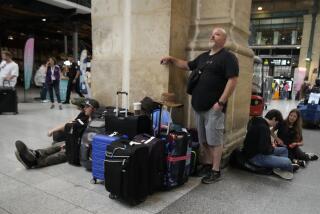Hundreds Die as Soviet Gas Blast Hits 2 Trains : Pipeline Explosion Along Trans-Siberian Link Erupts as Rail Cars Pass; 800 Reported Missing
- Share via
MOSCOW — A gas pipeline alongside the Trans-Siberian Railway exploded and burst into flames before dawn Sunday just as two trains passed each other simultaneously, and children, vacationers and other passengers were incinerated in a cyclone of fire. “Hundreds and hundreds” were killed, Soviet television reported.
More than 800 people were missing nearly 24 hours after the blast and fire, official Soviet media reported.
President Mikhail S. Gorbachev and a score of top leaders rushed to the accident site between two ridg es in the Ural Mountains. The blast occurred shortly after 1 a.m. in a wooded area near the city of Ufa on the Belaja River, about 750 miles southeast of Moscow, according to reports on Soviet television, radio and the Tass news agency.
A prominent politician said it was the worst railway accident in Soviet history.
Gorbachev, looking weary, appeared in a television interview saying he believes that negligence was behind the accident--the latest in a series of fatalities on the national rail network.
“I cannot say for sure right now, but experts are saying that once again we have negligence and violations in the operation of complex equipment,” he told the interviewer.
Local radio broadcasts called repeatedly for blood donations and urgent help from all doctors and nurses in the area. By day’s end, Soviet television showed medical personnel treating victims on stretchers, some with their faces bloody or blackened by fire and others bandaged head to foot.
One boy, identified as Alyousha, was apparently in shock and looked so glassy-eyed that the correspondent felt he needed to assure viewers: “He’s alive.”
“The exact figure of those killed by the accident is not yet known, but their number is measured by hundreds and hundreds,” the television said.
It also showed black smoke billowing from the scorched accident site, soldiers with shovels searching for bodies and the shells of train cars gutted by fire and overturned from twisted railway tracks.
‘Nothing Left to Bury’
“We will have to recommend cremation of some of the bodies. There is nothing left to bury,” said Anatoly Zykov, a senior Communist Party official in the region who was given the job of compiling a casualty list.
The explosion was caused by a heavy leak of liquefied petroleum gas seeping from a pipeline, much as a gasoline leak in a trackside pipeline caused an inferno that killed two people and injured 31 in San Bernardino, Calif., on May 25.
The blast came as passenger trains No. 211 and No. 212 were passing in opposite directions on runs between Siberia and a Black Sea holiday resort. It was so powerful that it shattered windows in a village seven miles away, the television reported.
Soviet media did not elaborate on the causes of the incident but reported that the government had immediately set up an investigating commission. Gorbachev, in his television interview, said there were signs that the gas had been leaking for several days.
“When the trains passed by, a spark set off the explosion,” he said. “It was real hell there.”
1,200 Aboard Trains
The two trains involved in the accident were carrying more than 1,200 people, Tass reported. “Fewer than 400 of them are as yet accounted for, including those dead,” the official Soviet news agency reported nearly 24 hours after the accident.
“Military units are combing the nearby woodland and mountains in the hope that some passengers were able to escape from the cyclone of fire,” Tass said.
Children on their way to a summer camp on the Black Sea were among the missing, Soviet television said.
A correspondent for the Communist Party daily Pravda, Vitaly Cherepanov, said a high-ranking local party official told him at least half of the people on the two trains were dead.
The Communist Party Central Committee declared today a day of mourning.
Supreme Soviet member Boris N. Yeltsin cut short a political rally in Moscow to call for a minute of silence in memory of those killed and then suggested that his supporters go home because of the tragedy.
‘There Were Whole Families’
“We’ve never before had such a high casualty toll on the railroads,” he said without giving figures. “A lot of children and their mothers died because they were returning home from the south, where they had been on vacation. There were whole families.”
The previous worst reported train disaster was in August, 1987, when two trains collided in a Russian coal town, killing 106 people.
The speed with which information about the accident was reported was a sign of Gorbachev’s policy of glasnost, or greater openness. Before Gorbachev became Communist Party leader in March, 1985, news of such accidents was reported only briefly weeks later, or not at all.
At the scene of the blast, doctors set up a makeshift field hospital in tents. Some of the wounded were flown by helicopter to hospitals in three nearby cities.
“It’s terrible. It’s monstrous,” said Mayor Mikhail A. Zaitsev of Ufa, where some of the victims were air-lifted. “Helicopters are constantly arriving with more injured.”
‘Eliminated by Fire’
Every car on the two trains was “either damaged or eliminated by fire,” Tass reported, adding: “A huge catastrophe has occurred.”
The Trans-Siberian line, which regularly carries foreign tourists, is the longest continuous track in the world, stretching about 5,775 miles from Moscow to the Soviet Far East port of Vladivostok and covering seven time zones.
The two passenger trains involved were traveling between Novosibirsk, the largest town in Siberia with a population of 1.3 million, and Adler, a health resort on the Black Sea at the mouth of the River Mzimta.
Premier Nikolai I. Ryzhkov, who directed rescue efforts after the December earthquake in Armenia, joined Gorbachev in rushing to the area. Defense Minister Dmitri T. Yazov, Health Minister Yevgeny I. Chazov and Russian Federation Premier Alexander V. Vlasov also flew to the scene, along with members of a governmental commission quickly set up by the Communist Party Central Committee.
“A mass campaign to collect blood has been launched in the towns of the region even though it is Sunday, and it is also being delivered to the Ural Mountains by helicopters,” Tass reported.
‘Work Without Rest’
“We do not remember such a stream of voluntary donors. The staff has to work without rest,” Tass quoted Nina Maidanyuk, a senior doctor in the nearby city of Chelyabinsk, as saying.
The tragedy was the latest in a series of fatalities over the last year on the Soviet national rail network, which is the world’s largest in both traffic and the amount of track. The 32 rail networks that make up the national grid carry 4 billion tons of cargo and 4.3 billion passengers annually.
The last serious accident on Soviet railways occurred a year ago, when 91 people were killed June 4 when three freight trains loaded with industrial explosives blew up in the Volga River valley city of Arzamas.
In all in the last year, Soviet media had reported 123 deaths in railway accidents, prompting a string of articles criticizing lax safety measures on aging railway lines.
RAIL DISASTERS June 6, 1981--In worst loss of life from rail disaster to date, estimated 800 killed in India when train plunges off bridge into Bagmati River in northern Bihar state.
Dec. 12, 1917--543 asphyxiated in tunnel near Modale, France.
1944--520 suffocate in tunnel in Salerno, Italy.
May, 1915--227 killed when three trains collide near Gretna, Scotland.
SOURCE: Reuters
More to Read
Sign up for Essential California
The most important California stories and recommendations in your inbox every morning.
You may occasionally receive promotional content from the Los Angeles Times.













